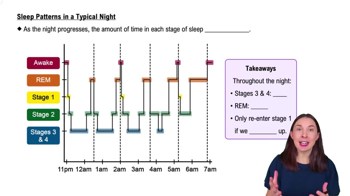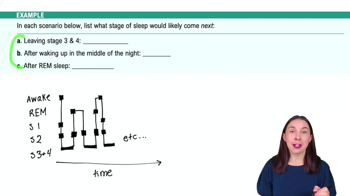Table of contents
- 1. Introduction to Psychology1h 43m
- 2. Psychology Research2h 20m
- 3. Biological Psychology2h 41m
- 4. Sensation and Perception28m
- 5. Consciousness and Sleep32m
- 6. Learning41m
- 7. Memory34m
- 8. Cognition37m
- 9. Emotion and Motivation35m
- 10. Developmental Psychology33m
- 11. Personality48m
- 12. Social Psychology41m
- 13. Stress and Health41m
- 14. Psychological Disorders44m
- 15. Treatment47m
5. Consciousness and Sleep
Sleep
Struggling with Psychology?
Join thousands of students who trust us to help them ace their exams!Watch the first videoMultiple Choice
Which conclusion describes the Cannon-Bard theory of emotion?
A
I am shaking and feeling afraid at the same time.
B
I am afraid because I am shaking.
C
The snarling dog is dangerous and that makes me feel afraid.
D
The snarling dog is dangerous but trapped inside a fence; therefore, I am not afraid.
 Verified step by step guidance
Verified step by step guidance1
Understand the Cannon-Bard theory of emotion, which posits that emotions and physiological responses occur simultaneously and independently.
Identify the key components of the theory: the simultaneous experience of emotion and physiological arousal.
Analyze each conclusion option to determine if it aligns with the simultaneous and independent occurrence of emotion and physiological response.
Consider the first option: 'I am shaking and feeling afraid at the same time.' This aligns with the Cannon-Bard theory as it describes simultaneous emotion and physiological response.
Evaluate the other options to see if they imply a sequence or causation between emotion and physiological response, which would not align with the Cannon-Bard theory.

 3:25m
3:25mWatch next
Master Circadian Rhythms with a bite sized video explanation from Hannah Gordils
Start learningRelated Videos
Related Practice


































































































![Race, Genes and IQ Differences | Bret Weinstein [Mini Clip]](https://img.youtube.com/vi/IztL_m3pd70/mqdefault.jpg)



































































































